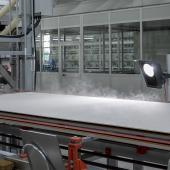Ceramic machinery: downturn in 2008 but Italy maintains its world leadership
The Italian ceramic and brick machinery and equipment manufacturers experienced a downturn in 2008.
The sector’s turnover fell by 5.8% last year to 1,825.5 million euro. The positive results achieved in the first half of the year were unable to offset the effects of the economic and financial crisis that hit the sector in the second half of 2008.
Export share remained unchanged at 73.9% of total turnover, confirming the Italian manufacturers’ world leading position. Exports remained close to 2007 levels, with just a small drop of 2.7%.
These are the main figures that emerge from the 17th National Statistical Survey conducted by ACIMAC, which provides a detailed picture of trends in the ceramic machinery sector.
Contraction in Italian market
After the boom of 2007, (+20.3% to 551.4 million euro), the Italian ceramic machinery market contracted last year. The turnover generated by the domestic market dropped to 476.5 million euro (-13.6%). This fall was due to the contraction in the two largest client sectors, ceramic tile and brick manufacturers, which were badly hit by the stagnation in the building and construction sector.
Exports remain steady
The Italian ceramic machinery sector confirmed its world leadership position in 2008.
Exports account for 73.9% of total turnover to a value of 1,349 million euro, slightly down (-2.7%) on 2007.
The Italian ceramic machinery manufacturers’ leading position is also confirmed by the fact that the pie-chart for the continental markets continues to be divided into fairly even slices. Europe is the leading market with a 39.3% share, followed by Asia, including the Middle East, at 32.8%, America at 16.4% and Africa at 11.3%.
Analysing the geographical areas covered by the study in greater detail, we find that the European Union remains the leading export market for Italian ceramic technology at 344.1 million euro (25.5% of the total) in spite of a 12 percentage point fall over 2007. Once again in 2008 the second largest market consisted of countries in the Middle East, which saw a 7.2% fall to 221.5 million euro (16.4% of the total).
Eastern European countries were in third place with 186.6 million euro, 14.3% up on 2007, and accounting for 13.8% of total turnover. The African continent has risen to fourth place with 152.1 million euro (up 7.2% on 2007) and an 11.3% share of the total.
With 144.8 million euro (+1.4%) South America accounts for 10.7%, down one place to fifth position amongst the leading export markets for Italian technology. Countries classified as “Others Asia”, including India, Thailand, Indonesia and Vietnam, rose by one place. These countries also showed the best growth performance: up 28.3% to 124.9 million euro (9.3% of the total).
Exports towards China, Taiwan and Hong Kong dropped by 8.4% to 96.0 million euro, accounting for 7.1% of total exports. North America on the other hand suffered a sharp downturn: -20.5% to 76.4 million euro (5.7% of total exports). As usual, Oceania was in last position with a turnover of 2.9 million euro, 71.4% down on the previous year.
Internationalisation
According to the last statistical survey, in 2008 Italian companies further strengthened their position abroad. The number of foreign companies in which Italian firms have a majority stake (greater than 51%) rose by 11 compared to 2007. As of 31 December 2008 there were 68 companies controlled by Italian groups with a total turnover of 281.6 million euro (1.8% up on 2007).
The structure of the sector
There were a total of 159 Italian suppliers of ceramic machinery in 2008, 8 fewer than the previous year. In almost all cases these were small companies with a turnover below 5 million euro. Small companies (turnover from 0 to 2.5 million euro) remained the most numerous, accounting for 47.2% of the total. By contrast, the majority of turnover, 69.1%, was generated by larger sized companies (turnover higher than 25 million euro). This is the only group of companies that continued to show a growth trend in 2008 in terms of their number and percentage of total turnover.
The number of employees fell by 215, from 7,560 to 7,345. Like other sectors, ceramic machinery companies also resorted to various forms of social shock absorbers during 2008 and the first few months of 2009 in order to adapt to the slowdown in demand and to reduce company costs.
Types of machinery
The percentages of individual types of machinery making up the sector’s total turnover remained unchanged. The core machinery of the production line, namely presses and moulds, accounted for 29% of total turnover, followed by kilns with 12.6%, glazing and decoration systems (12.5%) and earth preparation machinery (11.8%).
Client sectors
The breakdown into six client sectors remained unchanged in 2008. Tile producers continued to be the main users of Italian technology with a dominant share of total turnover: 75.3% corresponding to 1,378.6 million euro (8.9% down on 2007). In second place were the clay product manufacturers with an 11.1% increase in turnover to 265.3 million euro (14.5% of the sector’s total turnover).
Next came sanitaryware machinery with a turnover of 101.6 million euro, 7.8% down on 2007. The refractories market expanded for the second year running to reach 45.2 million euro, 20.8% up on 2007. Tableware machinery experienced a further 20.9% fall to 28.7 million euro. Sales of machinery for various ceramics performed well with increases in both the domestic and international markets.
Forecasts for 2009
2009 will be another difficult year for the manufacturers of machinery and equipment for the ceramic and brick industries. The international crisis has frozen investments in almost all markets resulting in a decrease in orders, most of which are now to adapt and service existing plants.
These considerations fuel forecasts of a fall in turnover and a possible rationalisation of the sector, which may speed up processes of aggregation and dimensional growth by companies.
“Nonetheless, our world leadership position is unchallenged, as is our companies’ ability to develop innovative solutions for customers and end users. This remains crucial a crucial factor as it is the only way for us to overcome this difficult period,” commented Acimac’s chairman Pietro Cassani. “Our companies are concentrating their efforts on research and development in the certainty that we will emerge from the crisis stronger than before.”
Did you find this article useful?
Join the CWW community to receive the most important news from the global ceramic industry every two weeks





















